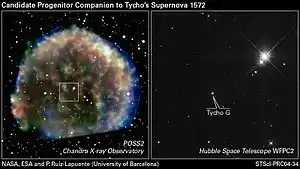Tycho G
Tycho G has been proposed as the surviving binary companion star of the SN 1572 supernova event. The star is located about 6400±1500 light-years away in the constellation Cassiopeia. It is a subgiant, similar to our Sun in temperature, but more evolved and luminous.
| Observation data Epoch J2000 Equinox J2000 | |
|---|---|
| Constellation | Cassiopeia |
| Right ascension | 00h 25m 23.59s[1] |
| Declination | 64° 08′ 02.0″[1] |
| Apparent magnitude (V) | 18.71[2] |
| Characteristics | |
| Spectral type | G0/1 IV[3] |
| Astrometry | |
| Radial velocity (Rv) | −79.22[2] km/s |
| Proper motion (μ) | RA: −2.50[2] mas/yr Dec.: −4.22[2] mas/yr |
| Parallax (π) | 0.5118 ± 0.1208 mas |
| Distance | approx. 6,000 ly (approx. 2,000 pc) |
| Details | |
| Mass | 1.0[3] M☉ |
| Radius | 1.32 - 2.63[3] R☉ |
| Luminosity | 1.9 - 7.6[3] L☉ |
| Surface gravity (log g) | 4.0[2] cgs |
| Temperature | 6,025[2] K |
| Metallicity | −0.13[2] |
| Rotational velocity (v sin i) | < 6[2] km/s |
| Age | 5.7[2] Gyr |
| Other designations | |
2MASS J00252358+6408019, [RCM2004]+Tycho G | |
| Database references | |
| SIMBAD | data |
Origin of the name
The supernova SN 1572 is often called "Tycho's supernova", named after Tycho Brahe who observed the "new star" in 1572. The postfix "G" originates from the candidate companion stars considered in a 2004 study, labelled Tycho A to Tycho V.[4]
Evidence for companion hypothesis
Tycho G is travelling away from us at nearly 80 km/s, much faster than the mean velocity of other stars in its stellar neighbourhood. It matches the properties of some models for the pre-supernova star system, although other studies exclude it.[5]
See also
References
- Cutri, R. M.; Skrutskie, M. F.; Van Dyk, S.; Beichman, C. A.; Carpenter, J. M.; Chester, T.; Cambresy, L.; Evans, T.; Fowler, J.; Gizis, J.; Howard, E.; Huchra, J.; Jarrett, T.; Kopan, E. L.; Kirkpatrick, J. D.; Light, R. M.; Marsh, K. A.; McCallon, H.; Schneider, S.; Stiening, R.; Sykes, M.; Weinberg, M.; Wheaton, W. A.; Wheelock, S.; Zacarias, N. (2003). "VizieR Online Data Catalog: 2MASS All-Sky Catalog of Point Sources (Cutri+ 2003)". VizieR On-line Data Catalog: II/246. Originally Published in: 2003yCat.2246....0C. 2246. Bibcode:2003yCat.2246....0C.
- Kerzendorf, Wolfgang E.; Yong, David; Schmidt, Brian P.; Simon, Joshua D.; Jeffery, C. Simon; Anderson, Jay; Podsiadlowski, Philipp; Gal-Yam, Avishay; Silverman, Jeffrey M.; Filippenko, Alexei V.; Nomoto, Ken'Ichi; Murphy, Simon J.; Bessell, Michael S.; Venn, Kim A.; Foley, Ryan J. (2013). "A High-resolution Spectroscopic Search for the Remaining Donor for Tycho's Supernova". The Astrophysical Journal. 774 (2): 99. arXiv:1210.2713. Bibcode:2013ApJ...774...99K. doi:10.1088/0004-637X/774/2/99.
- González Hernández, Jonay I.; Ruiz-Lapuente, Pilar; Filippenko, Alexei V.; Foley, Ryan J.; Gal-Yam, Avishay; Simon, Joshua D. (2009). "The Chemical Abundances of Tycho G in Supernova Remnant 1572". The Astrophysical Journal. 691: 1. arXiv:0809.0601. Bibcode:2009ApJ...691....1G. doi:10.1088/0004-637X/691/1/1.
- Ruiz-Lapuente, Pilar; Comeron, Fernando; Méndez, Javier; Canal, Ramon; Smartt, Stephen J.; Filippenko, Alexei V.; Kurucz, Robert L.; Chornock, Ryan; Foley, Ryan J.; Stanishev, Vallery; Ibata, Rodrigo (2004). "The binary progenitor of Tycho Brahe's 1572 supernova". Nature. 431 (7012): 1069. arXiv:astro-ph/0410673. Bibcode:2004Natur.431.1069R. doi:10.1038/nature03006. PMID 15510140.
- Pan, Kuo-Chuan; Ricker, Paul M.; Taam, Ronald E. (2014). "Search for Surviving Companions in Type Ia Supernova Remnants". The Astrophysical Journal. 792: 71. arXiv:1407.6829. Bibcode:2014ApJ...792...71P. doi:10.1088/0004-637X/792/1/71.

